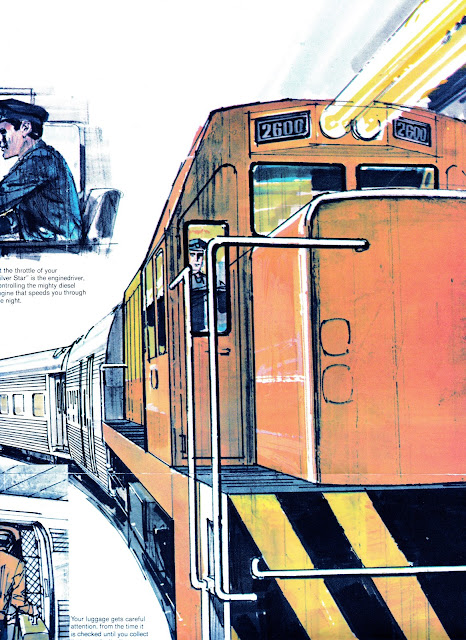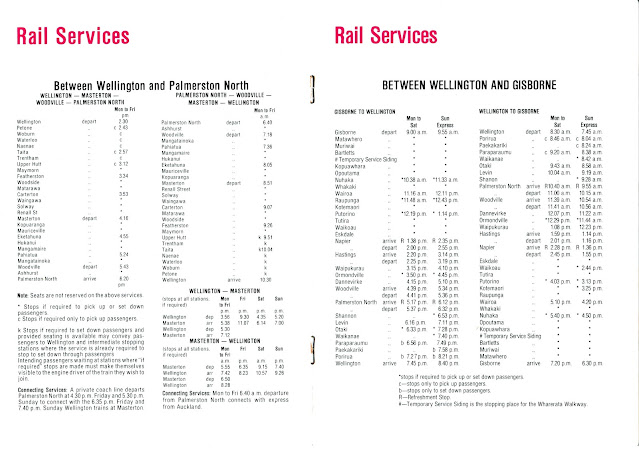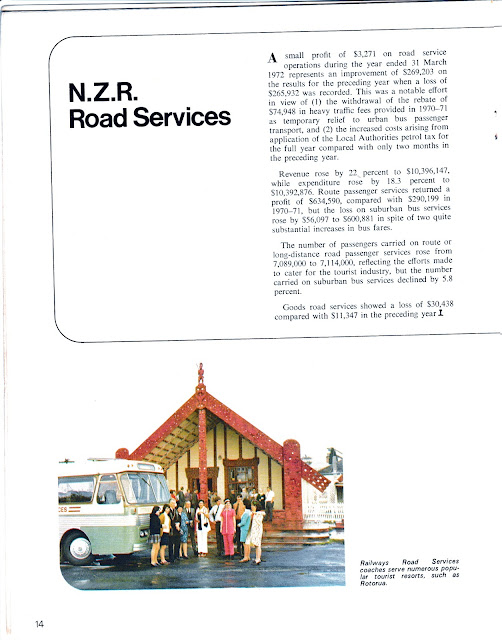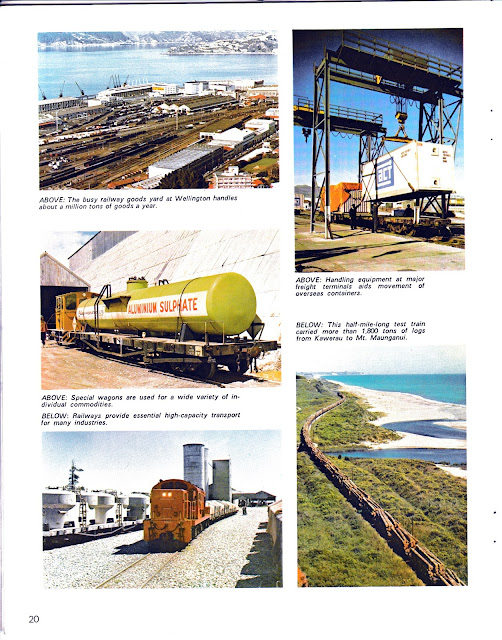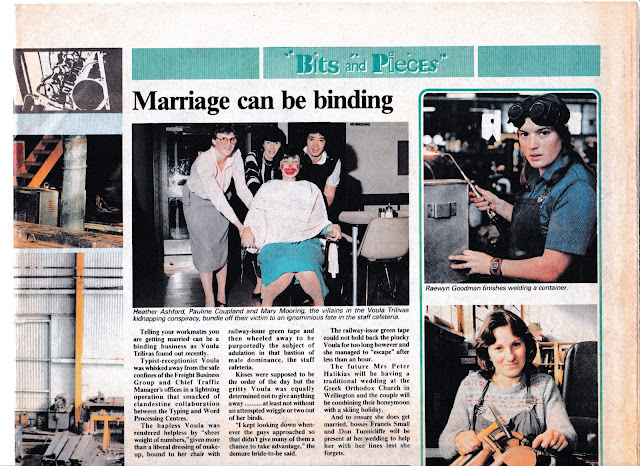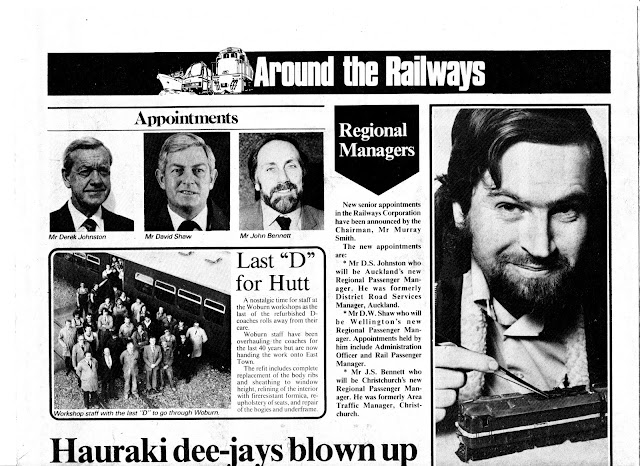In 1972 the Railways Department was facing a number of challenges, primarily the economic reality of the increasing unprofitability of suburban rail and bus services that it was obliged to operate with no local contribution to subsidies. However it did retain a statutory monopoly on most freight consigned further than 40 miles (New Zealand was not yet fully metric at the time), was dominating the inter-island shipping business (in no small part to its medium-long haul freight monopoly), and was the country's largest intercity coach operator. Challenges of inflation, highly inflexible industrial relations and the difficulties of being expected to trade at an operating profit, but having little mechanism to raise capital, or make significant operational changes without political support (as a government department) would only increase in the subsequent years.
This glossy annual report is silver not least because it represented the first year of operation of the Silverstar, which was and still remains, the most luxurious passenger rail service ever to operate on New Zealand railways.
 |
| NZR Annual Report 1972 contents page |
 |
| Forewords by the Minister and General Manager |
The overall review was for a loss of $4,327,580 in 1972 (over $71m in 2023 prices), which excluded interest on a loan from the International Bank for Reconstruction and Development. Revenue grew 16.3% but costs grew 12.3% primarily due to higher staff pay, higher cost of stores and imported materials and higher payroll taxes. Most of the growth in revenue came from freight. It was noted that the loss was an improvement of around $3.26m on the previous year! The depiction of the Southerner is notable, as this was NZR's first year of non-steam operation (excluding the vintage Kingston Flyer) and the Southerner was symbolic of what was then the modern NZR.
 |
| Introductory review |
The colourful network map has many lines now long gone, including Thames, Opunake (beyond Kapuni), Waiau, Ross, Methven, Kurow, Otago Central, Tapanui, Kingston, Mossburn and Tuatapere.
 |
| Rail network map 1972 |
The financial results show how road and ferry services generated a surplus (ferries quite significantly), but rail did not.
 |
| NZR financial results 1972 |
Railway working notes higher revenue was primarily due to increased charges, but noting that there was a a 4.5% decrease in tonnage consigned by rail. Some key points were:
- 91% of rail revenue was from freight, 7% from passengers and 2% from catering
- Nearly 73% of rail revenue was from the North Island, even though 1625 miles of track was open in the North Island to 1362 miles in the South Island (suggesting very low volumes on a lot of South Island branch lines)
- The Waimea Plains railway was partially closed on 1 April 1971 reducing network extent in the South Island
- Train miles run reduced by 2.4% partly due to dropping some railcar services and partly reduced freight volumes
- 483 locomotives in service, 276 main-line diesel, 14 electric and 191 shunters
- 15 DX locomotives arrived, but entry into service delayed by union demands for more pay
The rail freight section has a number of interesting points including:
- Average weight of a goods train in 1972 was 496 tons
- The transition to containerisation was only starting with 225 container wagons delivered during the year, with another 520 ordered
- Oddly, another 183 4-wheel Ks box wagons were delivered (these are really only suited to small-lots) and 21 petrol tank wagons, with another 571 Ks wagons on order. Odd because such wagons had low capacity to weight ratios.
- 600 4-wheel LPA open wagons for paper and paper products and 200 Uk container wagons were ordered from Japan, but completely knocked down for assembly in NZ workshops. This is a practice that later proved to be highly inefficient.
- Other wagons on order included 10 large Zp box wagons, 282 Us and 68 UsL flat-top wagons, and six Btk bulk tallow wagons.
- NZR reported "record productivity" in terms of net ton-miles per train-hour of 3,381. It is highly likely that a significant contribution to this will have been the replacement of steam traction with diesel.

Passenger services were a highlight that year, particularly the introduction of the Silverstar as the first air-conditioned passenger train in New Zealand. Patronage reportedly was better than expected, and images of the train interior, depicting a passenger receiving continental breakfast and newspaper in bed, a twinette cabin in seating layout, the buffet car and the train approaching Wellington near Kaiwharawhara are notable. The Blue Streak railcar patronage was good with optimism about the arrival of the Silver Fern railcars later in the year, and noting good patronage for the Southerner, and the newly launched Kingston Flyer.
Key facts included:
- A 6.9% decline in long-distance rail patronage, albeit with a 16.5% revenue increase due to an increase in fares
- 2.8% decline in suburban passenger services (which operated in Auckland, Wellington, Christchurch and Dunedin) noting the end of services in Christchurch except for those connecting with the Union Steam Ship Company ferries between Lyttelton and Wellington, due to insufficient patronage.
- 1.78m long distance trips were taken and 18.335m suburban trips. In 2019 it was 231,000 long-distance trips excluding the Capital Connection, but 38.5m suburban trips (for only Auckland and Wellington)
- Average revenue per trip for long-distance services was $2.37 ($38.93 in 2023 prices) and $0.152 for suburban services ($2.50 in 2023 prices)
- The Silverstar was described as being a first-step in a long-standing public demand for a high-class train comparable with overseas services, with attention now directed to upgrading and modernising other overnight services on the route (this would culminate in the launch of the Northerner in 1975)
- Noted that once the Silverfern railcars arrive the Blue Streak would be transferred to another route (this would be Wellington-New Plymouth).
- Noting the future introduction of a buffet-car express train called the Endeavour between Wellington and Napier.
- Noted that what was needed was intensification of public relations and publicity to convince the public that the services compare well with those overseas and to demonstrate that good rail travel facilities have an important part to play in the economy of the country.




NZR Road Services reported a small profit ($3,271) in the 1972 financial year (nearly $54,000 in 2023 prices), which was a significant improvement on a previous year's loss. It was noted that this was in spite of the removal of a temporary relief in heavy vehicle traffic fees for urban bus services and the introduction of the Local Authority Petroleum Tax. Key statistics included:
- 22% rise in revenue, with a minor increase in long-distance coach traffic, but a 5.8% decline in suburban bus patronage
- Long-distance services have a 11% surplus of revenue over expenditure, but suburban services have a 29% deficit of expenditure over revenue. In essence, long distance services cross subsidised suburban services.
- Goods road services also generated a minor loss of around 2% over revenue

Cook Strait Rail Ferries were the highlight financially of the Railways Department. With only two ferries at the time (Aramoana and Aranui) they were seriously worked over the year. The third ferry, the Arahanga, was delayed because the Scottish shipbuilders went into receivership, but it was launched in February 1972 and expected to be in operation later that year (as it was), for rail and motor vehicle traffic, not passengers. A contract for a fourth ferry had been let during the year (the Aratika as it would be) to be similar to the Arahanga (being for rail and road freight), but ultimately would be refurbished in 1976 to add passenger accommodation. It was noted that this was the first year the Railways Department took over direct control of the ferry operations, after it had contracted the Union Steam Ship Co. to operate the vessels on its behalf.
Key statistics included:
- 3% increase in rail freight carried
- Nearly 8% increase in cars carried
- 13% decrease in commercial vehicle carried
- Nearly 14% increase in passengers carried
- Gross revenue rose by 27.3% with expenditure rising by 23.5%
- Net revenue is around 20% higher than expenditure.
Other services noted include the supply of staff dwellings, outdoor advertising revenue and rentals of railway land and private sidings. This section also depicts an ultimately doomed proposal for high rise development on the site of Wellington Railway Station and the Paremata New World supermarket built on railway land at Mana (since significantly expanded).
Capital works were up by 63% on the previous year, primarily for locomotives, rolling stock and the third rail ferry. More than half of spending came from the depreciation reserves of the Railways Department, the balance from debt. Notable expenditure in the report was:
- New administration building in Wanganui
- New Wellington parcels depot
- Upgraded rail passenger terminal in Auckland
- New depot and garage for Road Services in Gisborne
- New diesel locomotive servicing facilities in Dunedin
- 12 more level crossing automatic warning devices
- Renewal or strengthening of 11 railway bridges
Noted was preparation for:
- New Centralised Traffic Control (CTC) signalling between Rolleston and Oamaru, Kawerau and Murupara and Matamata-Kinleith
- Mangaweka Deviation (completed 1983)
- New Porootarao Tunnel on the North Island Main Trunk
- Major redevelopment of the Picton railcard
Staff numbers were 20,688, a slight decline on the previous year of less than 2%. Note Kiwirail in 2023 had around 4,800 employees.
The last section was on planning and the environment which had a number of interesting points:
- Planning for railway facilities where growth in putting pressure on existing facilities, notably in Auckland, Napier-Hasting and Blenheim-Picton, Christchurch and Wellington
- A working party is studying movement of traffic between Auckland and Wellington to plan the future action needed in operating practices, motive power, signalling and track to meet demands up to the year 2000.
- Another working party studying the handling and transport of commodities to improve current methods in packaging, unitising, handling, transfer times, wagon design and documentation.
- The inherent efficiency of railway for volume movement of people and goods comes from its basic characteristics, enabling long trains to be formed hauled by a single power unit. It noted that 40 20ft containers could be hauled by a train of 20 wagons occupying 1,200 feet of track compared to 40 diesel trucks (it could really be 20 today!) occupying 5,000 feet of roadway with 100ft of braking distance.
- Diesel locomotives use less fuel per unit of work performed and emit less exhaust, further utilisation of railway capacity would reduce atmospheric and visual pollution, and road congestion, and the need for future road building.
It concludes with the claim that as "community awareness of the problems of pollution increases, so the realisation that railways can make an important and positive contribution towards the reduction of environmental problems will undoubtedly become recognised more fully".












